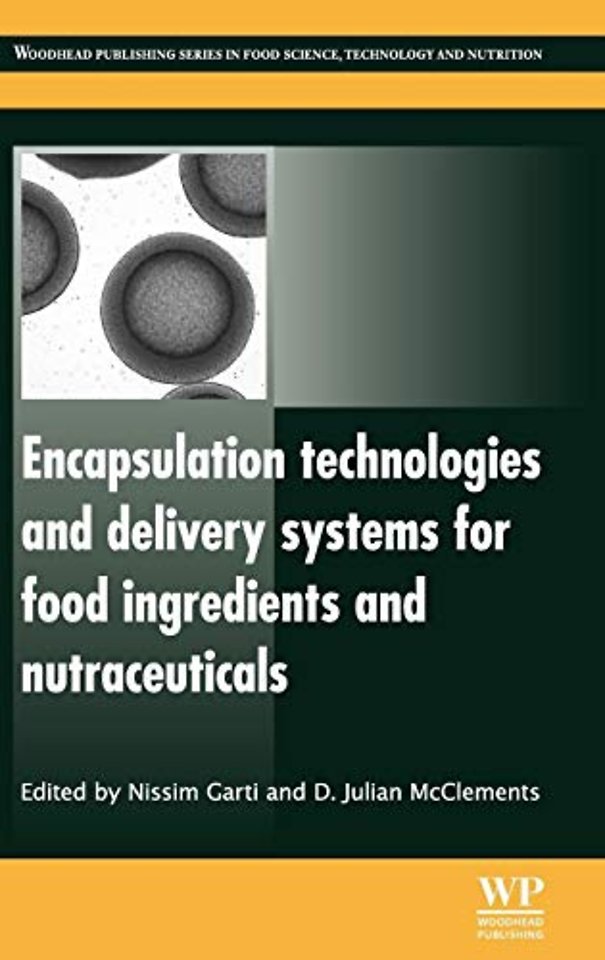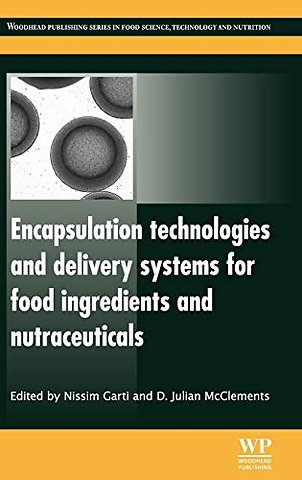<p>Contributor contact details</p> <p>Woodhead Publishing Series in Food Science, Technology and Nutrition</p> <p>Preface</p> <p>Part I: Requirements for food ingredient and nutraceutical delivery systems</p> <p>Chapter 1: Requirements for food ingredient and nutraceutical delivery systems</p> <p>Abstract:</p> <p>1.1 Introduction</p> <p>1.2 Active components and the need for encapsulation</p> <p>1.3 Fabrication and characteristics of delivery systems</p> <p>1.4 Particle characteristics, physicochemical properties and functional performance</p> <p>1.5 Future trends</p> <p>Chapter 2: Challenges in developing delivery systems for food additives, nutraceuticals and dietary supplements</p> <p>Abstract:</p> <p>2.1 Introduction</p> <p>2.2 Classes of food ingredients</p> <p>2.3 Formulating and designing microencapsulation systems for food additives, nutraceuticals and dietary supplements</p> <p>2.4 Encapsulated ingredients and applications</p> <p>2.5 The market for encapsulated ingredients and nutraceuticals</p> <p>2.6 Future trends</p> <p>2.7 Acknowledgement</p> <p>Chapter 3: Interaction of food ingredient and nutraceutical delivery systems with the human gastrointestinal tract</p> <p>Abstract:</p> <p>3.1 Introduction</p> <p>3.2 Model systems</p> <p>3.3 The human gastrointestinal tract</p> <p>3.4 Bioactive delivery system design</p> <p>3.5 Implications of research on functional food development</p> <p>3.6 Future trends</p> <p>3.7 Sources of further information</p> <p>Part II: Processing technology approaches to produce encapsulation and delivery systems</p> <p>Chapter 4: Spray drying, freeze drying and related processes for food ingredient and nutraceutical encapsulation</p> <p>Abstract:</p> <p>4.1 Introduction</p> <p>4.2 Principles and technical considerations of spray drying encapsulation</p> <p>4.3 Applications of spray drying for food ingredient and nutraceutical encapsulation</p> <p>4.4 Storage stability of spray dried encapsulated products and limitations of spray drying encapsulation</p> <p>4.5 Principles and technical considerations of freeze drying encapsulation</p> <p>4.6 Applications of freeze drying for food ingredient and nutraceutical encapsulation</p> <p>4.7 Storage stability of freeze encapsulated products and limitations of freeze drying encapsulation</p> <p>4.8 Future trends and conclusions</p> <p>Chapter 5: Spray cooling and spray chilling for food ingredient and nutraceutical encapsulation</p> <p>Abstract:</p> <p>5.1 Introduction: principles of spray chilling</p> <p>5.2 Spray cooling and spray chilling technologies</p> <p>5.3 Formulations and applications</p> <p>5.4 Future trends</p> <p>5.5 Sources of further information</p> <p>Chapter 6: Coextrusion for food ingredients and nutraceutical encapsulation: principles and technology</p> <p>Abstract:</p> <p>6.1 Introduction</p> <p>6.2 Principles of coextrusion</p> <p>6.3 Coextrusion technologies</p> <p>6.4 Formulations and applications</p> <p>6.5 Future trends</p> <p>6.6 Sources of further information</p> <p>Chapter 7: Fluid bed microencapsulation and other coating methods for food ingredient and nutraceutical bioactive compounds</p> <p>Abstract:</p> <p>7.1 Introduction: principles and purposes</p> <p>7.2 Definition of microencapsulation and fluidized bed coating</p> <p>7.3 Technology and machine design</p> <p>7.4 Particle characteristics, process parameters and applications of fluid bed microencapsulation</p> <p>7.5 Future trends</p> <p>Chapter 8: Microencapsulation methods based on biopolymer phase separation and gelation phenomena in aqueous media</p> <p>Abstract:</p> <p>8.1 Introduction</p> <p>8.2 Candidate biopolymer shell materials</p> <p>8.3 Biopolymer solution properties and microcapsule formation</p> <p>8.4 Encapsulation technology</p> <p>8.5 Traditional versus emerging complex coacervation encapsulation procedures</p> <p>8.6 Conclusions</p> <p>Part III: Physicochemical approaches to produce encapsulation and delivery systems</p> <p>Chapter 9: Micelles and microemulsions as food ingredient and nutraceutical delivery systems</p> <p>Abstract:</p> <p>9.1 Introduction</p> <p>9.2 Microemulsions: definitions and terminology</p> <p>9.3 Water-in-oil (W/O) and oil-in-water (O/W) microemulsions</p> <p>9.4 Solubilization of nutraceuticals in U-type microemulsions</p> <p>9.5 Microemulsion processes and applications</p> <p>9.6 Conclusions</p> <p>Chapter 10: Biopolymeric amphiphiles and their assemblies as functional food ingredients and nutraceutical delivery systems</p> <p>Abstract:</p> <p>10.1 Introduction</p> <p>10.2 Classification, composition, structure, properties and self-assembly of polymeric amphiphiles: proteins and peptides</p> <p>10.3 Classification, composition, structure, properties and self-assemby of polymeric amphiphiles: polysaccharides, oligosaccharides and polysaccharide-protein conjugates</p> <p>10.4 Binding and co-assembly of biopolymeric amphiphiles and nutraceuticals</p> <p>10.5 Mechanisms of solubilization and protection of hydrophobic nutraceuticals by biopolymeric amphiphiles</p> <p>10.6 Applications and future trends of biopolymeric amphiphiles for encapsulation and delivery of food ingredients and nutraceuticals</p> <p>10.7 Sources of further information and advice</p> <p>Chapter 11: Liposomes as food ingredients and nutraceutical delivery systems</p> <p>Abstract:</p> <p>11.1 Introduction</p> <p>11.2 Formation and structures of liposomes</p> <p>11.3 Liposome preparation methods</p> <p>11.4 Characterization of liposomes</p> <p>11.5 Encapsulation by liposomes</p> <p>11.6 Liposome stability</p> <p>11.7 Liposome applications in food systems</p> <p>11.8 Stability of liposomes to gastrointestinal environment</p> <p>11.9 Conclusions</p> <p>Chapter 12: Colloidal emulsions and particles as micronutrient and nutraceutical delivery systems</p> <p>Abstract:</p> <p>12.1 Introduction</p> <p>12.2 Physico-chemical stability, texture, taste and flavour</p> <p>12.3 Appearance of dispersions in food products</p> <p>12.4 Bioavailability of functional ingredients</p> <p>12.5 Applications: overview of minerals and vitamins</p> <p>12.6 Applications: vitamin A</p> <p>12.7 Applications: vitamins D, E and K</p> <p>12.8 Nutraceuticals: carotenoids</p> <p>12.9 Nutraceuticals: water-soluble polyphenols</p> <p>12.10 Nutraceuticals: water-insoluble polyphenols</p> <p>12.11 Alkaloids and other photochemicals</p> <p>12.12 Conclusions and future trends</p> <p>12.13 Acknowledgements</p> <p>Chapter 13: Structured oils and fats (organogels) as food ingredient and nutraceutical delivery systems</p> <p>Abstract:</p> <p>13.1 Introduction</p> <p>13.2 Research into organogelation as food ingredient and nutraceutical delivery systems</p> <p>13.3 Nutraceuticals and their use in organogels</p> <p>13.4 Delivery of carotenoids: lycopene and β-carotene</p> <p>13.5 Health effects and delivery of phytosterols</p> <p>13.6 Conclusions</p> <p>Chapter 14: Hydrogel particles and other novel protein-based methods for food ingredient and nutraceutical delivery systems</p> <p>Abstract:</p> <p>14.1 Introduction</p> <p>14.2 Food grade polysaccharides and proteins for hydrogel formation</p> <p>14.3 Development of polysaccharide- and protein-based hydrogels: physical crosslinking approach</p> <p>14.4 Development of polysaccharide- and protein-based hydrogels: chemical crosslinking approach</p> <p>14.5 Polysaccharide- and protein-based hydrogels</p> <p>14.6 Diffusion as a controlled-release mechanism</p> <p>14.7 Degradation as a controlled-release mechanism</p> <p>14.8 Other controlled-release mechanisms</p> <p>14.9 Applications in food science</p> <p>14.10 Future trends</p> <p>Part IV: Characterization and applications of delivery systems</p> <p>Chapter 15: An industry perspective on the advantages and disadvantages of different flavor delivery systems</p> <p>Abstract:</p> <p>15.1 Introduction</p> <p>15.1.2 Industrial considerations</p> <p>15.2 Physical chemistry of flavor delivery systems: interfaces in emulsion-based delivery systems</p> <p>15.3 Barrier properties and permeation in core/shell delivery systems</p> <p>15.4 Molecular weight distributions in glassy systems</p> <p>15.5 Conclusions and future trends</p> <p>Chapter 16: An industry perspective on the advantages and disadvantages of different fish oil delivery systems</p> <p>Abstract:</p> <p>16.1 Introduction</p> <p>16.2 Health benefits associated with long chain omega-3s</p> <p>16.3 Fish oil delivery systems used in industry</p> <p>16.4 Future trends: emerging strategies and technologies</p> <p>16.5 Sources of further information and advice</p> <p>Chapter 17: An industry perspective on the advantages and disadvantages of iron micronutrient delivery systems</p> <p>Abstract:</p> <p>17.1 Introduction</p> <p>17.2 Delivery systems of iron</p> <p>17.3 Criteria for selection of food product, iron compound and delivery system</p> <p>17.4 Application of iron delivery systems in dry food products</p> <p>17.5 Application of iron delivery systems as simulated rice and food sprinkles</p> <p>17.6 Application of iron delivery systems in dairy products and aqueous food products</p> <p>17.7 Conclusions and future trends</p> <p>Chapter 18: Properties and applications of different probiotic delivery systems</p> <p>Abstract:</p> <p>18.1 Introduction</p> <p>18.2 Microencapsulation techniques: physical methods</p> <p>18.3 Microencapsulation techniques: chemical methods (hydrocolloid gel methods)</p> <p>18.4 Supporting materials</p> <p>18.5 Special treatment</p> <p>18.6 Application of microencapsulated probiotics in food products</p> <p>18.7 Future trends</p> <p>Index</p>

